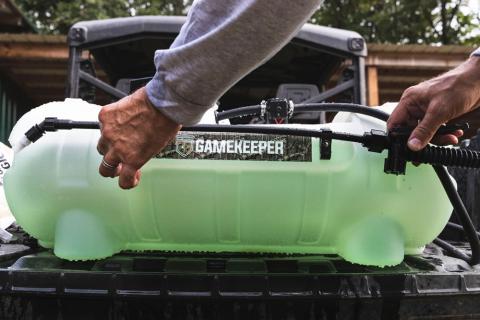Krissy Knox of Harrisburg, Oregon, was named Mossy Oak ProStaffer of the Year for 2020. She’s hunted mule deer her entire life, and in the last 5 years she’s hunted them exclusively with a bow. Tim Anderson, who manages the Mossy Oak ProStaff, recognized Krissy, who’s been a Mossy Oak Pro for the past 14 years, at the ATA (Archery Trade Association Show) for her contributions to hunting. Krissy said, “Tim surprised me with that award and made me cry.”
Get to Know Mule Deer Hunter Krissy Knox
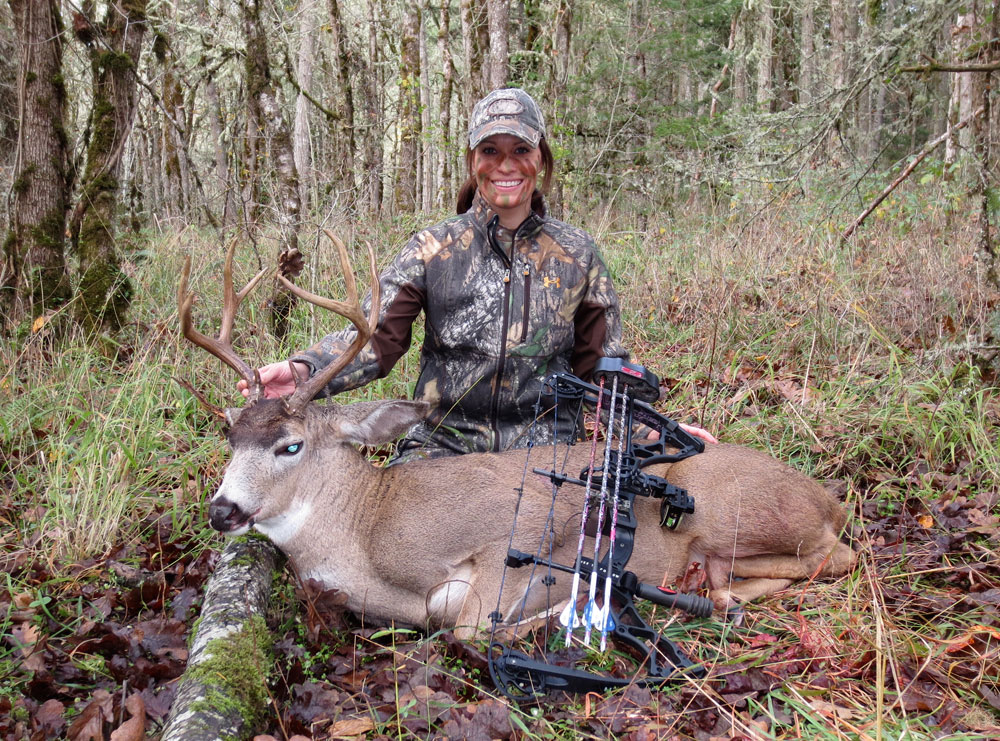
Mossy Oak was the first company for whom I ever worked. I’m extremely loyal to Mossy Oak, and that company is extremely loyal to every ProStaff member it has. Earning that award was a very special moment for me and a huge honor. Part of the award was being able to go on a whitetail hunt with Mossy Oak this coming season (2021) in Texas. I’ve never taken a whitetail, although I’ve taken plenty of blacktail deer and mule deer. I’m hoping to do a trifecta this year, with the whitetail hunt in Texas, a blacktail hunt in Oregon and a mule deer hunt in Montana. God willing, this will be my first trifecta.
Besides hunting mule deer and elk, I always hunt turkeys with a bow. And, I’ve been lucky enough to take 20-30 Rio Grande gobblers with my bow. We do have some Merriam’s gobblers in Oregon, and I have taken a few of those birds. I’ve also taken some intergrades that were technically Rio Grandes but that had some white feathers on them. (Sometimes Merriam’s and Rio Grande turkeys interbreed with intergrades being the result).
Getting Ready for Archery Mule Deer Season
Oregon’s bow season for deer arrives the last few days of August, so we have one of the earliest bow seasons for deer in the nation – generally starting around August 28. Mule deer hunting is a totally different experience from hunting white-tailed deer or blacktails. Early-season mule deer in our section of the country are very unpredictable. Oregon mule deer are one of the few animals that hunters don’t get to hunt during the rut. In September, we hunt elk in the rut, our late blacktail archery season in November is when the blacktails are in the rut, and we can hunt turkeys during their breeding season. But when we’re hunting early-season mule deer, we don’t have the advantage of hunting these deer in the rut.
The BLM land (Bureau of Land Management) that I hunt is what we called “reprod” forestation (reforested land that’s either been cut over or burned and has plenty of thick regrowth), and the vegetation is very thick. You can’t see very far, so you can’t use the spot-and-stalk method that most hunters associate with mule deer hunting. Where I hunt is all public lands, so once we’re in a tree stand or a ground blind, we’re at the mercy of the mule deer. We can’t do anything to manipulate the hunt in our favor. We can’t call to them or rattle to them. So, 90 percent of what’s required to take a mule deer where we hunt has to take place before the season opens. We try to get our trail cameras out during the month of May or, if we’re late getting our cameras out, no later than June. We’ll put out five trail cameras in a small area to try to determine where the mule deer are bedding, where they’re feeding and watering, and which trails they’re using to go from bedding to feeding to watering.
We also want to identify the time of day the muleys are moving. That tells us where we need to put a tree stand or a ground blind before opening day of bow season. We also have to be conscious of the wind. If the stand’s close to what we’ve defined as the bedding area, then when we decide on a possible stand site, we also want to know what direction we can go to that stand without having the wind carrying our scent to the bedding site before we reach our stand site. Often, we’ll spend a lot of time trying to determine the route we’ll take to our stand based on the wind conditions that are most dominant in that area. We rely heavily on onX Maps, and mark a route that we have to take to reach our blind, and what wind we must have on the day we hunt to reach that blind with a favorable wind. We also put into our onX program whether this stand is a morning stand or an evening place. OnX offers a 20-percent discount. Learn more about how to get that discount here.
The area we hunt is between 5,000-6,000 feet of elevation. So, we have to be conscious of thermals also when we’re considering wind direction. Oregon has some unusual hunting rules different from any other state. For instance, we can’t bait predators, but we can bait deer and elk. And thank God that we can bait them, because the reprod homes such thick growth that without bait, the mule deer would be hard to pattern. In many of these places, we may not be able to see more than 20 yards around our stand.
For bait, we use mineral blocks. Many of the regions in Oregon don’t have the minerals in the soil to help grow big antlers. So, by putting out mineral blocks, we’re not only baiting our animals, but we’re helping give them the minerals they need during the time of the year that they’re growing antlers. And, we’ll put out some form of deer attractant at the same site where we place our mineral blocks.
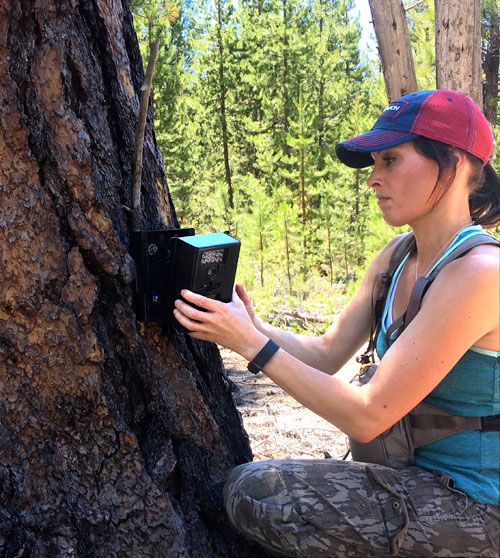
Getting Ready for Archery Mule Deer Season
Some hunters will put their cameras out in May or June and then not check them until a week or two before the season arrives - trying to keep their human odor out of the area they plan to hunt. However, I check my trail cameras about every 2 weeks. I always want to know what bucks my trail cameras are getting on film. Also, if I’m checking my cameras every 2 weeks, and the mule deer are still coming into the cameras, then I believe they more or less have become accustomed to my human odor.
I always spray down with some type of odor killer when I’m checking my cameras. My theory on scent killer is that you’re never going to get rid of all your human odor. However, if I spray down, and a mule deer does pick up my human odor, he may believe I’m 100 yards away. Since my odor has been reduced drastically from the spray, and I’m really 20 yards from him, I may get that split second I need to release my arrow before he spooks.
I’m kind of a camera junkie. When I look through my pictures on my trail camera, I get the same feeling I do on Christmas morning just before we open packages. Because we’re putting our cameras out before the season, the mule deer bucks are in bachelor groups. We may find 5-6 bucks running together, and then on other cameras, I may have only one buck showing up on my cameras all season long. I make a decision on where I’m going to hunt based on: how frequently I see a buck on camera; how many bucks consistently come past a trail camera; what time they move by a trail camera; and how dependable those bucks are that are coming by my trail camera.
I’m not picky about antlers. If I have a camera that has a 3-point buck (6-pointer eastern count) showing up at my stand site almost every day, and on another camera, I have pictures of a 4-point buck (8-pointer eastern count) every three days, I’ll plan to take the 3-point buck. I like to have meat in my freezer, and I like to hunt deer that are showing up almost every day rather than sitting in the stand for 3-4 days hoping that 4-pointer will come by my stand. And, if I have my son Jesse, who’s 10 years old, with me in the blind, I may shoot the first 4-horned buck I see just to let him enjoy the experience of seeing a deer coming in, taking the shot and recovering the animal. In 2020, Jesse took his first two turkeys and his first buck.
We go ahead and set up our tree stands and ground blinds several weeks before bow season arrives. All our blinds are at least 1-2 miles from any road. When we set up a ground blind, we throw dust all over them to take the shine off the blinds. We also brush them in really well and pile-up dirt on the inside and outside edges of the blind. Then none of our human odor gets out under the blind. We’ll also put a blanket down inside the blind. So, when we move around, we make hardly any noise. We also spray our blinds down with some type of scent killer.
Because our mule deer season arrives so early, we get to hunt bucks in the velvet. When mule deer bucks are in the velvet, they’re easy to pattern. However, when they lose that velvet, and they’re in hard horn, they’re not as predictable as they’ve been when they’ve been in the velvet. Many of them become nocturnal and, somehow, they know that they are more vulnerable when they’re in hard horn and become much more elusive.
Hunting the Route 65 Muley
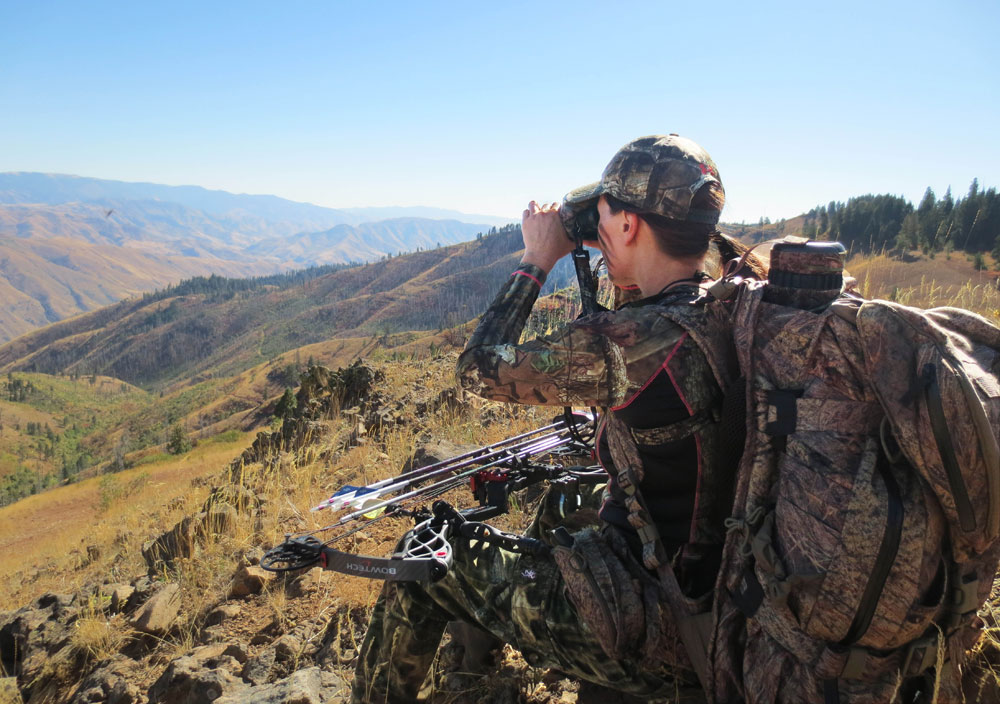
In 2017, I injured my back during the summer months and was unable to do as much work preseason scouting as I normally would. I hardly could get out of bed in the morning. We were late putting out our trail cameras - not until July 4th. Because our stands were a mile to two miles away from where we parked, I couldn’t check the cameras as often as I liked. I didn’t feel good about the season because I hadn’t done as much homework as I felt like I needed to do to have a successful season. I couldn’t sit in a chair in the blind for more than 5 minutes without tears; my back was hurting that bad. I thought there was a really serious chance that I wouldn’t get to hunt during the 2019 early bow season.
Early mule deer season is a special time for me and my family; we may have as many as 20 people in camp, with only two to three - maybe 5 - people hunting. But we cook together, and we help each other with cutting up the meat and packing out the animals. Early season for mule deer is almost as important to my entire family as Christmas is.
Most seasons, I’ll go to our deer camp and set up all the blinds early, but I couldn’t in 2017 due to my back. My boyfriend, Stacy Locks, was busy working and didn’t have time to set up the blinds either. So, three days before the season, Stacy, my son Jesse, and I went up to our campsite and set up our tree stands and our ground blinds - instead of three weeks before the season. I was bummed out. I was almost certain that I’d be disappointed with this year’s family mule deer hunt.
The blind that I planned to sit in on opening morning was somewhat further off the trail than I normally would set up my blind. Since we had a group of six bucks on a trail camera coming into this location, I thought my odds of taking a buck would be best to hunt this spot and sit in this blind. I shoot my Bowtech Realm all year long and I shoot a Wac’Em 3 blade 100-grain broadhead, so I felt confident that if I had an opportunity to take a buck, I could deliver the arrow within the kill zone. My broadhead was a fixed blade, since in Oregon, expandable broadheads weren’t legal to hunt with until 2020.
Stacy and I went into this blind at 1:30 a.m. I was convinced that getting in well before daylight would have a direct bearing on how many deer I’d see and drastically would increase my chances of taking a nice buck. My back was still hurting. I remember that as soon as we got in the blind and had everything set up, I said a prayer and took some ibuprofen to help numb the pain in my back. The morning was cold. I had hand warmers on my shoulder and my back - hoping to keep my muscles warm enough to be able to draw the bow and shoot - if I saw any one of the six bucks that we were hunting.
I shoot a 53-pound bow. I can shoot a 60-pound bow, but I’ve had so many times when I’ve had to draw the bow and hold it for a long time or held the bow for a long time and had to let it down and then redraw when a deer stepped in through an opening where I was planning to take a shot, that I shoot the lighter bow. I believe more in shot placement to take down a deer than I do in poundage to effectively harvest a deer.
That day, we sat in the blind a long time in cold weather before the sun finally came up. We only opened one window in the blind, and we tried to be as quiet as possible because we weren’t sure from which way the group of bachelor bucks might come.
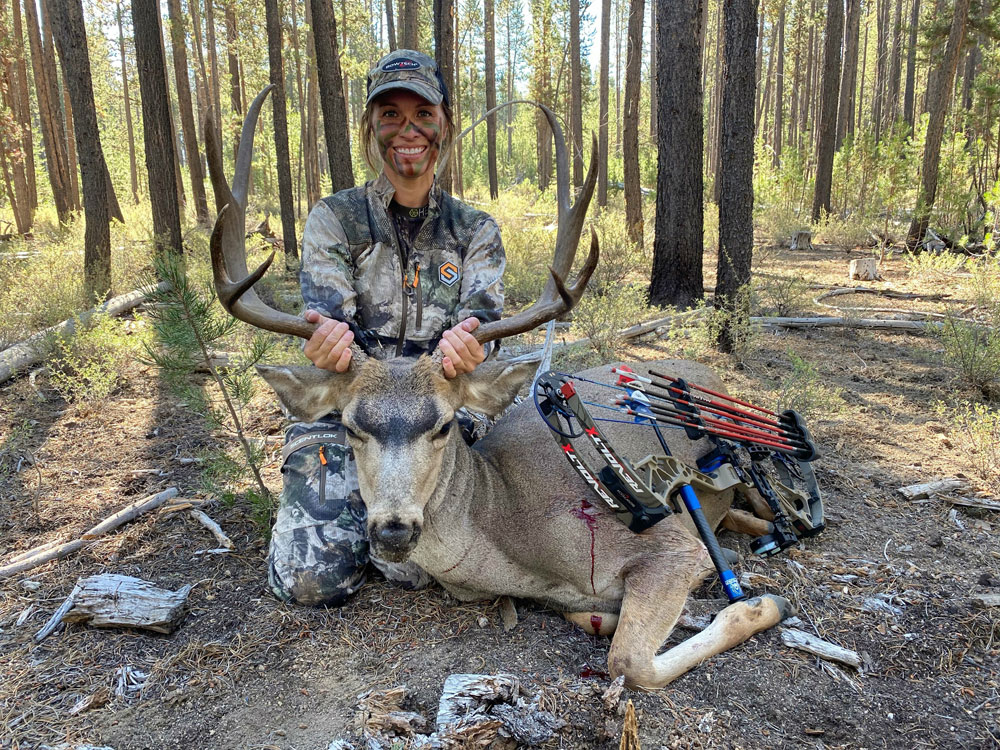
As the sun provided enough light to see, my ibuprofen was wearing off, and my back was really starting to hurt. I was thinking to myself, “I hope a buck comes in quickly, because I don’t know how long I can sit in this blind with my back hurting like this.” But 45 minutes after daylight, I saw movement off to my right. Stacy could tell by the intensity of the way I was sitting and looking that I’d seen something he hadn’t seen. He didn’t move a hair. Out of my peripheral vision, I spotted the nose of a deer. I leaned forward to see if the nose had antlers, and I saw this 4x4 buck that we’d watched on camera all year long. He was definitely a shooter buck. The buck was 40 yards away, looking directly at the blind and very nervous. I could tell by the buck’s posture that he wanted to come down the trail in front of the blind. The next time I leaned forward to look at the buck, he’d vanished, and I thought I’d missed my chance to take a really nice buck on opening day.
I was almost in tears because I really wanted to take that buck, and he seemed to have disappeared. However, in less than an hour, the group of six bucks showed up. They came from the same direction from where the 4x4 had come. I wasn’t going to be picky; I was going to take any one of those bucks that gave me an opportunity to shoot. But then, as the bucks spread out, I saw this ginormous 6x6 buck that we’d had trail-camera pictures of throughout the summer. He was in perfect velvet - none of the velvet had been raked off. His antlers were completely covered, and he was still wearing his summer coat, so he was very light-colored.
Stacy couldn’t see the bucks because of where he was sitting in the blind. But he said he saw my eyes getting as big as softballs, so he knew I was tuned in on a buck. The buck was about 40 yards away. He was the last of the group of six bucks to come out in front of the blind. All six bucks were feeding around the blind, and I felt that at any moment one of those bucks would wind us and spook the whole group. The other bucks were feeding calmly out in front of us, so the big 6x6 didn’t hesitate to come in and feed with his band of brothers. The big buck stepped right into my shooting lane, but there was another buck standing in front of the 6x6, another buck to his left, a third to his right, and there was a buck directly behind him, so I couldn’t take the shot.
Finally, the buck that was 12 yards from the blind moved away, and all the bucks’ heads were down or looking away from us. I thought to myself, “I’ve got to draw my bow now.” Next, the other bucks moved out and away from the big 6x6, and I had a clear shot at 28 yards with the buck standing broadside to me. I settled my pin sight just behind the crease in the deer’s shoulder and released the arrow. I heard that “thwap” sound when the deer took the arrow. As soon as the arrow hit the buck, Stacy whispered, “He’s dead, he’s dead.” I saw the direction the buck went, but all the other bucks broke to run. There was so much dust in front of the blind that I lost sight of my buck. The buck started back the way he’d come to us, and then he went downhill and into some thick trees. So, the first thing I did after the shot and seeing where the buck went was text my brother, Ryan Hay, and tell him what had happened. He wanted to get out of his tree stand, come over to where we were and walk the blood trail with us. But I asked him to stay in his tree stand and told him that I’d call him when we found the buck.
We stayed in our stand for about an hour before we went after the buck. We found my arrow about 10 yards from where I’d shot the buck. It was covered with lung blood. When we reached the buck, the first thing we noticed was that he was much bigger than what he appeared to be on our trail cameras. I called my mom and dad who were staying with my son Jesse back at camp, and Dad said, “Stay where you are. We’re all going to come and see the deer you’ve shot.” Then my brother and sister-in-law got the message, and they came too. The whole family helped us pack this buck out.
Based on our trail-camera pictures, we had named this buck Route 66 because we thought he was a 6x6, but once we had him down and checked out his antlers, we saw he was only a 5x6. So, we changed his name to Route 65. We name all of our bucks we see on trail cameras to keep up with them. About a week or two later when I pulled the trail-camera pictures from the spot where I’d taken Route 65, there were pictures of the big 4-point that had come into the blind first. He was watching us as we tracked the buck down the hill. We named the big 4x4, Harry Applebottom.
Downing the Mule Deer Harry Applebottom
By 2020, my back felt better, and I was able to shoot my bow and put out our trail cameras before May 10. From the season before, we knew where we should put trail cameras up because we’d gotten pictures of several really nice bucks from the year before. But those bucks were very unpredictable and not patternable. Some of these groups of bucks only would show up about every eight days. But I didn’t feel like there were any of the bucks that we’d had on camera from 2019 that would show up consistently enough for me to want to take them. However, I noticed that at the stand site where I’d shot Route 65, that several smaller bucks were coming into that stand. I finally saw a 3-point I thought I’d take. I planned to take my son Jesse with me in the blind. Then he could see a buck being harvested. I felt like I had a really good chance of taking this buck. Because elk season arrives at the same time in Oregon as mule-deer season does, we only hunt the first two weekends of mule deer season before we start hunting elk.
But then, as often happens, 1-1/2 weeks before opening weekend of mule deer season, all the bucks that we had trail pictures of disappeared. Since we weren’t getting any muley pictures, I was becoming concerned and worried about how the season would develop. But just before opening day, we started getting pictures of muley bucks, and they were all in hard horn. After seeing the muley bucks in hard horn, then we understood why they had vanished - because that’s usually what happened just before the bucks shed their velvet and went into hard horn. However, we’d never seen the bucks go into hard horn before the beginning of the season before.
The week before the season opened up, Harry Applebottom showed-up on our trail camera right in front of the blind I’d hunted from the previous year and taken Route 65. My son Jesse likes to make up names for the bucks we get on trail cameras. He goes with me when I check my cameras, he marks the routes that we take to our stand sites, he helps pack out meat, and he’s as much as part of the hunt as any of us are. So, on the way home, he’s making up names for the bucks he’s looking at from the trail-camera pictures we’ve gotten. I can’t remember who said it, but someone said, “We should call him Harry Applebottom,” which was a stupid name we thought of to make Jesse laugh. However, the name stuck. Jesse laughed and laughed when we came up with that name for the muley.
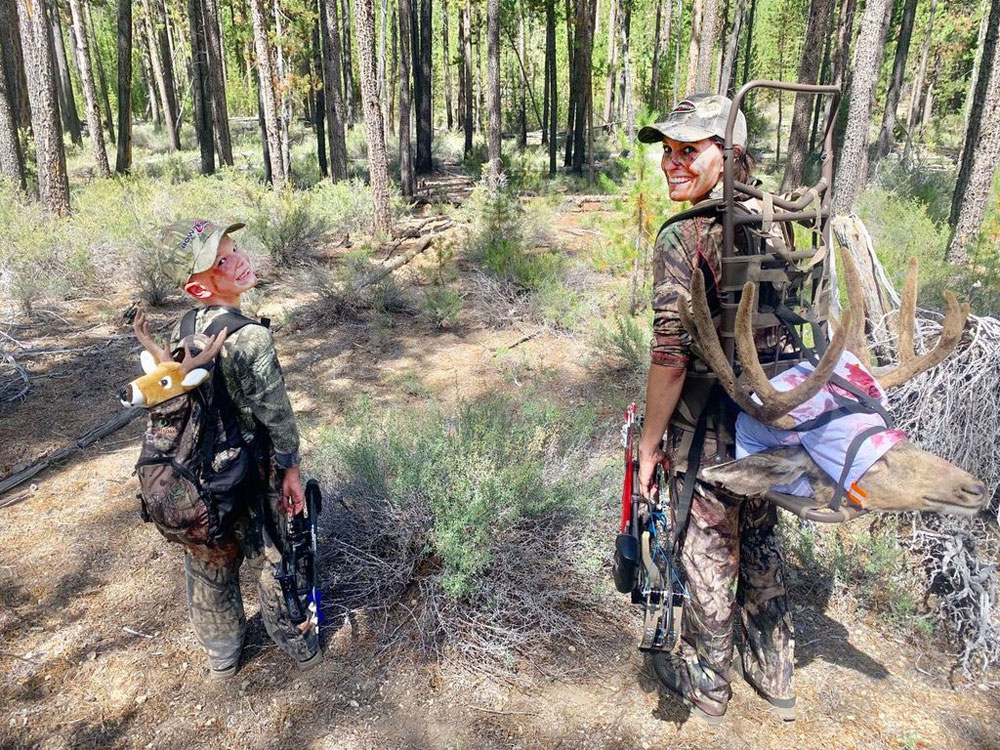
In the trail-camera pictures, we could see that the buck was in hard horn with big chocolate antlers and had a dark gray fall coat. He was completely opposite of the buck I’d killed the year before and named Route 65. His body was much bigger, his rack was much wider, and he was just a bigger deer than Route 65 had been. He came in to the blind site the same way he’d come in the year before. He was extremely cautious, and we had pictures of him twice the week before the opening of mule-deer season. We’d put the blind in the same place we’d put it the year before. The trail camera was in the same spot where it had been. What was really strange was Harry Applebottom seemed to become more patternable after he was in hard horn than he’d been the year before when he was in the velvet. Something else that was different was this buck was coming into our stand site later in the morning than he’d appeared the year before. He was showing up around 9:30 a.m., but in 2019 he appeared right after daylight.
In 2020, Stacy’s work schedule changed, and he wasn’t going to be able to hunt with me and my family for opening weekend. So, I decided I’d hunt by myself. My brother Ryan was hunting about 10 miles away from me. Opening morning, I wanted to sit in a tree stand because I didn’t get to hunt from a tree stand in 2019. However, I didn’t see any bucks I wanted to take on opening day. The following day, I returned to the blind where I’d seen the muley - Harry Applebottom - and taken the Route 65 muley.
I walked in in the dark. About 10 a.m., Harry Applebottom slipped into my stand site. I’d been sitting for a long time and decided to stand up in the blind and stretch. I wanted to peek out both sides of my blind to try to spot a mule deer. When I did, I saw the nose of a deer 16 feet from me on the left side of my blind. As I could see more of the buck, I realized he was Harry Applebottom. He had those hard-horned chocolate antlers and was wearing that gray coat he’d put on for the winter. He was huge. Even though I didn’t spook him, I felt certain he knew I was in the blind. For about an hour, this buck moved around the outside of the blind but never gave me an opportunity to take a shot. He stayed out at about 40 yards, and any time he heard any noise he’d jump. Harry was very much on edge, so I sat back in my chair and relaxed. Finally, the buck turned and started walking away from me. I knew he would pass within 30 yards of my blind. While he was looking away, I came to full draw, but at the sound, he took off like a rocket.
I let down my bow, and told myself, “You just blew your chance to take Harry Applebottom!” I knew I had to go home that afternoon and work the rest of the week, and I wouldn’t be able to hunt. I’m a bookkeeper on a big farm in the Willamette Valley, the Grass Seed Capital of the World. Our farm is about 3000 acres and raises mostly forage seed grasses. We also run a warehouse that cleans seeds for other farmers. I knew I would come back the next weekend, but I thought since I’d spooked Harry Applebottom, I probably wouldn’t get another chance to take him. I felt confident that I probably could take a fork horn or the 3x3, and I was okay with that. But I hated I’d missed my chance to take Harry Applebottom. All these thoughts were going through my head as I sat in the blind totally disappointed.
When I returned home, Stacy and I talked. He encouraged me to sit in the same blind the next weekend because he said, “This buck has been very patternable. I believe you’ll get another chance to take him this coming weekend.” So, the next weekend, we returned to camp Friday evening. I made the decision to sit in that same blind all weekend long. I went to the blind on late Friday afternoon and remained in the blind until dark. As I stood up and started getting my gear together, I heard a footstep in the dirt right next to the blind. Later when I checked my trail camera, I saw that Harry Applebottom was right outside my blind where he’d been the week before. He’d come in when the sky was pitch dark. Once he heard me move, he’d walked away. I sat in that blind Saturday and Sunday. Monday was Labor Day, so I was off. That day was when all the wildfires started in Oregon. As the sun came up, I looked out of the blind and spotted a lot of smoke. I decided that I’d end my season and leave my blind at 11:30 a.m. I was sitting as still as I could - trying not to breathe - and I had my bow with an arrow nocked in my lap.
Finally, I heard a footstep as the buck stepped on some of that squishy dirt right outside my blind. I instinctively knew that was Harry Applebotttom. He walked up to the side of the blind and didn’t have a clue that I was only 6 feet from him. Then he backed up and walked around the blind, so I stayed calm. For 40 minutes while this buck was outside of and around my blind, I sat absolutely still - except for my nervous shaking.
Then, Harry Applebottom walked to the same opening where I’d shot the Route 65 muley the year before. I drew the bow and took the exact same shot that I’d taken on Route 65. I heard that “whack” sound indicating that I’d hit Harry’s shoulder blade. I panicked just a little thinking that I might have hit him square in the shoulder. Then I looked at my watch and saw it was 10:30 a.m. I called my brother and found that Ryan was already back at camp. I told him what had happened, where I’d aimed, what I’d heard, and that I was really nervous because I felt certain that my broadhead had cut into the shoulder blade.
“Stay where you are, and I’ll be there shortly,” Ryan said. As I waited, I could see that the smoke was getting darker, and more of it was coming into my area, and that more than likely, I was surrounded by fire. There was one fire about 2 miles away, the big fire was 50-60 miles away, and the smoke was rolling in because it was a very windy day. The weather was becoming hot. I knew if we found this buck, we’d need to process him quickly and get him out of there before the fire got too close.
When I couldn’t stay in my blind any longer, I went to the spot where I’d shot the buck, found a portion of my arrow and saw that it was covered in lung blood. I’d listened after the shot; I’d heard the buck stumbling through the woods; and finally he was silent. So, I was confident that he was down. I looked up and could see a portion of the buck’s hide on the ground out in front of me. I called Ryan and said, “Okay, I know he’s down; come find me.” When we got up to the buck, we saw that he’d gone down 32 yards from where we’d found Route 65 the year before.
Harry Applebottom didn’t get as far down the trail as Route 65 had. When we saw those chocolate horns and that gray winter coat, we hardly could believe that this buck was shot at the same spot as Route 65. However, Route 65 had been in total velvet with a total summer coat. This buck was so very different looking. I had them both mounted, and hung them so they’re sort of looking at each other. I couldn’t believe that I’d taken two bucks out of the same stand and arrowed them at the same spot, and both had died on the same trail a year apart. I’d enjoyed a very unusual and very exciting 2 years of early-season mule-deer hunting in my home state of Oregon.
Although I’m not going to hunt mule deer this year (2021), and I’ll hunt black-tailed deer instead, I left my camera in the same spot as it was two years before to see what kind of bucks may be at the same spot. To be honest, I’m going to miss seeing Harry Applebottom this season.














